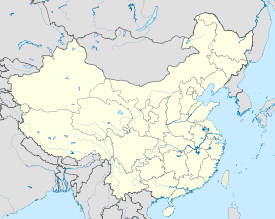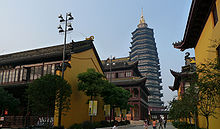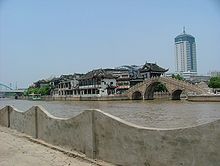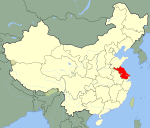- Changzhou
-
For other uses, see Changzhou (disambiguation).
Changzhou — Prefecture-level city — Chinese transcription(s) – Chinese 常州市 – Pinyin Chángzhōu Shì – Wu Chinese Zaontsei Zy Changzhou is highlighted on this map Location in China Coordinates: 31°47′N 119°58′E / 31.783°N 119.967°ECoordinates: 31°47′N 119°58′E / 31.783°N 119.967°E Country China Province Jiangsu Government – Mayor Yao Xiaodong (姚晓东) Area – Prefecture-level city 4,385 km2 (1,693.1 sq mi) – Urban 1,864 km2 (719.7 sq mi) Population (2010 census)[1] – Prefecture-level city 4,591,972 – Density 1,047.2/km2 (2,712.2/sq mi) Time zone China Standard (UTC+8) Postal code 213000, 213100 (Urban center)
213200, 213300 (Other areas)Area code(s) 519 GDP 2009[1] - Total CNY 251.870 billion (USD 37.05 billion) - per capita CNY 56,861 (USD 8,364) - Growth  11.7%
11.7%License Plate Prefix 苏D Local dialect Wu: Changzhou dialect Website http://www.changzhou.gov.cn Changzhou (Chinese: 常州; pinyin: Chángzhōu; Wade–Giles: Ch'ang-chou; Gwoyeu Romatzyh: Charng jou; formerly romanized as Changchow) is a prefecture-level city in southern Jiangsu province of the People's Republic of China. It was previously known as Yanling, Lanling, Jinling, and Wujin. Located on the southern bank of the Yangtze River, Changzhou borders the provincial capital of Nanjing to the west, Zhenjiang to the northwest, Wuxi to the east, and the province of Zhejiang to the south. The city is situated in the affluent Yangtze Delta region of China.
Contents
History
"The Ruins of Yancheng" (Chinese: 淹城遗址), comprise the remains of a walled city located in the Wujin district of Changzhou that was founded over 3000 years ago at the beginning of the Western Zhou dynasty. The earliest record of a settlement on the site of modern Changzhou is as a commandery founded in 221 BC at the beginning of the Qin Dynasty. Changzhou got its present name meaning "ordinary prefecture" in AD 589. Following construction of the Grand Canal in AD 609, Changzhou became a canal port and transshipment point for locally-grown grain, and has maintained these roles ever since. The rural counties surrounding Changzhou are noted for the production of rice, fish, tea, silk, bamboo and fruit.
During the Taiping Rebellion of the 1850s, one of five palaces housing the leaders of the so-called "Kingdom of Celestial Peace" was constructed in Changzhou. Today the ruins of the "King's Palace" can be found near the People's No.1 Hospital.
In the 1920s, Changzhou started to attract cotton mills. The cotton industry got a boost in the late 1930s when businesses began relocating outside of Shanghai due to the Japanese occupation. Unlike many Chinese cities, Changzhou continued to prosper even during the upheavals of the cultural revolution of 1966-76. Today it is an important industrial center for textiles, food processing, engineering (diesel engines, generators, transformers and other machinery), and high technology.
Climate
Climate data for Changzhou (1971−2000) Month Jan Feb Mar Apr May Jun Jul Aug Sep Oct Nov Dec Year Average high °C (°F) 7.1
(44.8)8.6
(47.5)12.9
(55.2)19.6
(67.3)25.1
(77.2)28.3
(82.9)31.8
(89.2)31.6
(88.9)27.1
(80.8)22.2
(72.0)16.0
(60.8)10.0
(50.0)20.03
(68.05)Average low °C (°F) 0.0
(32.0)1.4
(34.5)5.2
(41.4)10.9
(51.6)16.3
(61.3)20.9
(69.6)25.0
(77.0)24.7
(76.5)20.1
(68.2)14.3
(57.7)7.9
(46.2)2.0
(35.6)12.39
(54.31)Precipitation mm (inches) 44.6
(1.756)53.7
(2.114)89.2
(3.512)81.2
(3.197)102.4
(4.031)189.3
(7.453)171.7
(6.76)116.1
(4.571)92.2
(3.63)68.7
(2.705)52.7
(2.075)29.6
(1.165)1,091.4
(42.969)Avg. precipitation days (≥ 0.1 mm) 8.7 9.8 13.0 11.4 11.7 12.8 12.8 11.3 9.5 8.7 7.0 6.1 122.8 Source: Weather China Administration
The prefecture-level city of Changzhou administers seven county-level divisions, including five districts and two county-level cities.
- Zhonglou District (钟楼区)
- Tianning District (天宁区)
- Qishuyan District (戚墅堰区)
- Xinbei District (新北区)
- Wujin District (武进区)
- Jintan City (金坛市)
- Liyang City (溧阳市)
Education
Changzhou is an educational hub and is home to several universities, including Changzhou University, Hohai University (Changzhou campus), Jiangsu Teachers' University of Science and Technology, Jiangsu Teachers' University of Technology, and Changzhou Institute of Technology. The city also has a number of prominent secondary schools, including the Changzhou Senior High School of Jiangsu Province and the Changzhou International School.
Economy
Changzhou's traditional role has been that of a commercial center and in particular a distribution center for agricultural produce, which was shipped by canal to the north and later, to Shanghai. The city began to develop a cotton textile industry in the 1920s, and cotton mills were established in the late 1930s, when Japanese attacks drove many Chinese businesses to invest outside Shanghai.
The city has remained a textile center and the most important location in Jiangsu Province for weaving[citation needed]. It also has large food-processing plants as well as flour-milling, rice-polishing, and oil-pressing industries. After 1949 it also developed as a centre of the engineering industry. Qishuyan, some 10 kilometres (6.2 mi) southeast of Changzhou, has one of the largest locomotive and rolling stock plants in China. Other engineering works in Changzhou produce diesel engines, generators, transformers along with agricultural and textile machinery. At the time of the Great Leap Forward in 1958 a steel plant was also built to provide raw material for heavy industry.
Since 1908, Changzhou has been linked by rail with Shanghai and Nanjing (see below for transportation).
Up until now, Changzhou has remained one of the most developed cities in Jiangsu, ranked third after Suzhou and Wuxi. The city's 2009 GDP per capita of ¥70,103 in 2009, less than that of Suzhou and Wuxi but more than the capital city Nanjing, ranked the city third in Jiangsu, .
Changzhou is also one of the top business cities in China. According to Forbes ranking, Changzhou was the 9th best business city in mainland China in 2008.
Industrial Zones
- Changzhou Export Processing Zone
Approval for the establishment of Changzhou Export Processing Zone was given in June 2005 with a planned area of 1.66 square kilometres (0.64 sq mi). Near to Shanghai and Nanjing via convenient transportation links, the zone began operation in October 2006. Investors enjoy a series of preferential policies whilst all handle export procedures are handled inside the export processing zone. The zone focuses on electronic information, electromechanical integration and new materials.[2]
- Changzhou National Hi-Tech District
Changzhou National Hi-Tech District (CND) is a state-level high-tech industrial development zone. It is located in the northern part of Changzhou city. With a population of 500,000 and an area of 439 square km, the district is 160 kilometres (99 mi) from Shanghai to the east and 110 kilometres (68 mi) from Nanjing to the west. The district represents the highest-level and most sophisticated industrial park in Changzhou. More than 1,300 foreign companies and over 5,000 local industrial enterprises have been registered within the district of which around 40% are from European and American countries. Industries encouraged include engineering machinery, transformer & transmission equipment, automotive, locomotive & locomotive components, parts, precision machinery, biotechnology, pharmaceuticals, photo-voltaic (PV) and new materials, chemicals, garment and textiles production, computer software and research & development. Some major investors include Terex, Komatsu, Ashland Chemical, Johnson, Caltex Oil Corp., Disa, +GF+, Rieter and General Electronics.[3]
Transportation
Railway
Located just south of the Chang Jiang (Yangtze River), Changzhou is situated on the main Shanghai-Beijing rail line and is one of the main stops on the busy Shanghai-Nanjing route.
Air travel
Changzhou Benniu Airport is approximately 15 kilometres (9.3 mi) from the city center. There are flights to Beijing, Guangzhou, Shenzhen, Shenyang, Kunming, Harbin and Dalian.
Roads
- China National Highway 312
- Shanghai-Nanjing Highway
- Yanjiang Highway
- Changzhou-Nanjing Highway
Bus Rapid Transport System
Use of the Bus Rapid Transit System costs one yuan (or, if a Changzhou Bus Card is used, either three or six jiao depending on the type of card) and provides access throughout Changzhou. The BRT has the following specifications: separate bus lanes or bus-only roadways, a vast network of routes and corridors, high capacity buses operating both outside and inside these corridors, greater passenger volume as compared to that in mixed traffic lanes (-3000 pphpd), enhanced station environments (not just simple bus shelters), automated pre-boarding fare collection and fare verification, street level boarding and alighting, low emission vehicle technology (Euro III or higher), weather protection on station platforms, centralized system controls, real-time next bus information display, a distinctive marketing identity, high-quality passenger service at bus stations, segregated bike lanes along main corridor(s) as well as station access for disabled persons. The BRT is also located in the following cities: Beijing, Chongqing, Dalian, Changzhou, Guangzhou, Jinan, Hangzhou, Hefei, Kunming, Xiamen, Zhengzhou.[4] and Wulumuqi. A metro network is nevertheless in planning stage.
Elevated road
Changzhou built its first elevated road, the "Outer Ring Elevated Road", in 2007 and it came into use in 2008. In 2009, the plan for a second elevated road became part of the city's development blueprint.
Culture and folklore
The Changzhou dialect is a member of the Wu Chinese language family.
Comb Lane in Changzhou is the scene of the last farewell of Jia Baoyu with his father in the classic novel A Dream of Red Mansions.
Other famous handicrafts of Changzhou are silk embroidery in a "crisscross" style and carvings made from green bamboo.
Noted snacks made in Changzhou include pickled radish, sesame candy, sweet glutinous rice flour dumpling with fermented glutinous rice, and silver thread-like noodles.
Tourism
Changzhou is the home of the China Dinosaur Park (simplified Chinese: 常州恐龙园; traditional Chinese: 常州恐龍园; pinyin: Chángzhōu Kǒnglóng Yuán) located in the Xinbei District of the city. The 5A rated Dinosaur Park has a collection of dinosaur bones and fossils from all over China. The park has 50 various fossils and more than 30 amusement programs including the Brontosaurus Roller Coaster and the Whirling Dinosaur Carriage. The fossils are located in a museum housed in a single building and the amusement rides are spread throughout the park which is categorized into six themed areas. Besides fossils and family oriented rides, Dinosaur Park is home to a giant panda and sea lions.[5]
The city is also home to the Tianning Temple— one of the largest Zen Buddhist temple and monasteries in China. The city recently rebuilt the Tianning pagoda in the temple grounds, which is adjacent to Hongmei Park. The pagoda, called the Tianning Baota, was first built during the Tang Dynasty (AD 618 907). Since that time it has been destroyed and rebuilt five times. The current reconstruction is built to the height specification of 153.79 metres (504.6 ft). This makes it the tallest pagoda in China and perhaps also the world. Both the Hongmei Park and Tianning Temple are located just to the east of the city centre.[6]
As Changzhou is noted for its combs, the city has reconstructed its Bamboo Comb Lane area with contemporary architecture. Changzhou combs can be purchased in most places in the city.
There is the Hong Mei Park, which includes a small children's amusement park, a zoo, a rose garden and many scenic waterways. Of historical interest in the park is a historical pavilion with exhibits related to the Changzhou comb industry. In addition, there is another pavilion which displays locally produced root carvings. The park attracts large numbers of people during holidays and is often dotted with a variety of vendors.
Other sites include Changzhou's sunken city and area of archaeological ruins from the Spring and Autumn Period.
Changzhou also has attractive gardens such as the Wei Yuan.
Notable people
A Qing dynasty poet declared "there are none such under heaven as Changzhou, where famous persons come from." Numerous memorial halls in Changzhou and the surrounding area commemorate its famous citizens, including soldiers, scholars, revolutionaries, industrialists, physicians, artists and writers.
- Su Dongpo (also known as Su Shi; 1036–1101), poet and essayist lived and died here.
- Sheng Xuanhuai (1844–1916), late Qing Dynasty bureaucrat and reformer.
- Zhao Yuanren (1892–1982), prominent linguist.
- Hong Shen (1894–1955), pioneering dramatist and filmmaker was born here.
- Liu Haisu (1896–1994), prominent artist.
- Lu Lan (1987-), Olympic athlete and badminton player. Won the woman's championship at the 2009 BWF World Championships.
- Lu Simian (1884–1957), historian and member of the Doubting Antiquity School
- Qu Qiubai (1899–1935), former General Secretary of the Communist Party of China and prominent Marxist thinker and writer. Named "Changzhou San Jie" together with Yun Daiying and Zhang Tailei.
- Yun Daiying (1895–1931), revolutioner and pioneer of early Communist Youth activities.
- Zhang Tailei (1898–1927), one of the founders of Chinese Communist Party, first Chinese ever working in Communist International.
- Hua Luogeng (1910–1985), prominent mathematician.
References
- ^ a b "常州市2009年国民经济和社会发展统计公报" (in Simplified Chinese). Changzhou Municipal Statistic Bureau. 2010-03-01. http://www.cztjj.gov.cn/node/Tjsj_Tjgb/2010-3/1/15_46_53_388.html. Retrieved 2010-06-30.
- ^ RightSite.asia | Changzhou Export Processing Zone
- ^ RightSite.asia | Changzhou National Hi-Tech District
- ^ http://www.chinabrt.org/en/cities/changzhou.aspx
- ^ http://www.cnkly.com/
- ^ Xinhua (2007-04-30). "Buddhists gather to inaugurate world's tallest pagoda". China Daily. http://www.chinadaily.com.cn/china/2007-04/30/content_864654.htm. Retrieved 2007-04-30.
External links
- Government website of Changzhou (Chinese) (English)
- Changzhou city guide with open directory (Jiangsu.NET)
Jiangsu topics General Geography Cities • Grand Canal of China • Yellow Sea • East China Sea • Xishan Island •
Yangtze River • Lake Tai • Hongze Lake • Yangcheng Lake • Huai RiverEducation Culture Visitor attractions Purple Mountain • Sun Yat-sen Mausoleum • Ming Xiaoling Mausoleum • Jiming Temple • Nanjing Yangtze River Bridge • Hanshan Temple • Huqiu Tower • Grand Buddha at Ling Shan • Chaotian Palace • Qixia Temple • Tianning Temple PagodaJiangsu Province county-level divisions Nanjing: Xuanwu District · Baixia District · Qinhuai District · Jianye District · Gulou District · Xiaguan District · Pukou District · Luhe District · Qixia District · Yuhuatai District · Jiangning District · Lishui County · Gaochun County
Wuxi: Chong'an District · Nanchang District · Beitang District · Binhu District · Huishan District · Xishan District · Wuxi New District · Jiangyin City · Yixing City
Xuzhou: Yunlong District · Gulou District · Jiuli District · Jiawang District · Tongshan District · Quanshan District · Pizhou City · Xinyi City · Suining County · Pei County · Feng County
Changzhou: Zhonglou District · Tianning District · Qishuyan District · Xinbei District · Wujin District · Jintan City · Liyang City
Suzhou: Jinchang District · Canglang District · Pingjiang District · Huqiu District · Wuzhong District · Xiangcheng District · Wujiang City · Kunshan City · Taicang City · Changshu City · Zhangjiagang City
Nantong: Chongchuan District · Gangzha District · Haimen City · Qidong City · Tongzhou District · Rugao City · Rudong County · Hai'an County
Lianyungang: Xinpu District · Lianyun District · Haizhou District · Ganyu County · Guanyun County · Donghai County · Guannan County
Huai'an: Qinghe District · Qingpu District · Chuzhou District · Huaiyin District · Jinhu County · Xuyi County · Hongze County · Lianshui County
Yancheng: Tinghu District · Yandu District · Dongtai City · Dafeng City · Sheyang County · Funing County · Binhai County · Xiangshui County · Jianhu County
Yangzhou: Guangling District · Weiyang District · Hanjiang District · Yizheng City · Jiangdu City · Gaoyou City · Baoying County
Zhenjiang: Jingkou District · Runzhou District · Dantu District · Yangzhong City · Danyang City · Jurong City
Taizhou: Hailing District · Gaogang District · Jingjiang City · Taixing City · Jiangyan City · Xinghua City
Suqian: Sucheng District · Suyu District · Shuyang County · Siyang County · Sihong CountyCategories:- Cities in Jiangsu
- Changzhou
Wikimedia Foundation. 2010.






